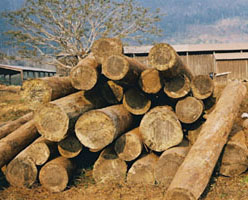SUMMARY
 Agriculture
and Irrigation
Agriculture
and Irrigation
Water from the Mekong River and its tributaries is used for human activities
such as agriculture, and is needed to sustain important ecological resources
such as wetlands. Rice agriculture is the most important human economic
activity in the basin; however, agricultural activities can exert important
influence on water quantity and quality in the basin. Agriculture in upland
areas of the basin differs from lowland areas, and even within those two
general divisions of the basin, agriculture can differ greatly from area
to area.
Agriculture and irrigation have, and continue to be, a dominant influence
on the landscape and ecosystems of the Mekong River basin. Agriculture
takes place in upland areas of large and small tributaries, and in lowland
areas, mainly on the floodplain of the Mekong River and its major tributaries.
Swidden (slash and burn) agriculture is practiced in many upland areas
– this type of agriculture has a long history and is intensifying. Lowland
agriculture is dominated by rice production in river floodplain areas.
The floodplains provide large tracts of relatively flat, nutrient-rich
land. Large areas are being cultivated for production of rice and other
crops in the Mekong River delta in Viet Nam and upstream along the main
river and lower reaches of most tributaries. Significant areas of crop
production occur along major tributaries such as the Tonle Sap River in
Cambodia, the Xe Bangfai River in Lao PDR and the Mun River in Thailand,
and are important for local economies.
The Mekong River is believed to have potential to irrigate several million
ha of agricultural land. Full realization of this potential will undoubtedly
increase existing competition for resources, such as use of water for
intensive rice production versus fish production. Water demand is greater
in the dry season when the river is low.
The flood-pulse cycle brings an annual rhythm of nutrient addition and
ecological activity in the floodplain. Fertilizers are commonly used,
including farmyard manure or chemical fertilizers, and these have impacts
on nutrients inputs into the river systems. Chemical pesticides are used
to control insects in many rice cultivation areas. In many rice-farming
areas, fish are grown in small ponds and/or are captured in the rice fields.
Wetlands
Important wetlands exist throughout the Mekong Basin, including the Mekong
River Delta, portions of the Mekong River mainstem, and wetlands on tributaries
to the Mekong River. Wetlands are important for biodiversity, food production,
flood control and ecosystem function, but are subject to a number of serious
threats from human activity.
Conversion of wetlands to agricultural land can result in the elimination
of the wetland ecosystem and species that depend upon it. Fish use the
annual inundation of floodplains along the Mekong River and its tributaries
for spawning and rearing, and have evolved to match critical stages of
their life history to the timing and magnitude of seasonal floods. Salinity
in parts of the Mekong River and its floodplain and tributaries can be
altered in several ways. Some soils, particularly in the delta area, have
high levels of acidic sulphate and, when disturbed, have potential to
increase the acidity of surrounding and downstream waters. Pesticides
that are commonly used in agriculture to control insects and other pests
usually go beyond the place where they are intended for use, and enter
receiving waters where they can cause ecological damage.
Nutrients can increase in river and wetland areas as a result of fertilizers
commonly used in agriculture and from other sources such as domestic waste.
Irrigation works can create environments that are suitable for proliferation
of parasites, by creating seasonal water at locations and times it did
not previously occur.
Forestry
The changing sequence of forest communities along the length of the Mekong
River is an important source of biodiversity and biological resiliency.
Forests provide a number of important functions for stream ecosystems,
including shade and temperature moderation, bank stability and erosion
control by providing solid root mass and ground cover, and nutrients and
food sources.
Plants and animals found in a around the water are adapted to the combination
of conditions that exist in different types of streams. Removal of the
surrounding forest will change conditions making them unsuitable for some
species and more suitable for others. Significant changes in plant and
animal community structure can result. Particularly on smaller streams,
the forest canopy limits the amount of light penetrating to the water
surface. Removal of riparian vegetation will decrease this shading effect,
which in turn can result in elevated water temperatures.
The removal of forest cover can affect the quality, quantity and timing
of stream flows. If trees are removed from a large portion of a watershed,
flow quantity can increase substantially. The ultimate impact depends
on the amount of vegetation removed and proximity of the removal site
to the stream. Increases in flood peak can occur if vegetation in the
areas closest to the stream is removed. Long-term loss of riparian vegetation
can result in bank erosion and channel widening.
Forest cover is declining in all Mekong River Basin riparian countries.
At present, losses of forest cover can be attributed to a number of activities
including:
Excessive and/or inefficient commercial logging;
Shifting cultivation;
Encroachment for human settlements;
Farming and infrastructure development; and
Intensive fuel wood collection.